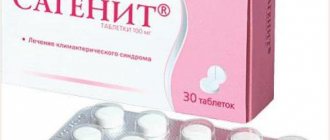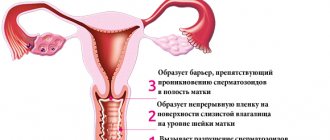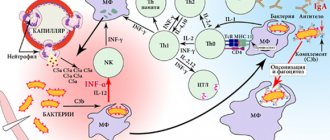Pharmacological properties of the drug Clostilbegit
Clomiphene (2-[4-(2-chloro,-1, 2-diphenylethenyl)phenoxy]-N, N-Diethylamine dihydrogen citrate (mixture of E- and Z-isomer)). The active ingredient of the drug is a non-steroidal anti-estrogen that stimulates ovulation. The mechanism of action is explained by the ability to specifically bind to estrogen receptors in the hypothalamus and ovaries. The drug in low doses enhances the secretion of gonadotropic hormones (prolactin, follicle-stimulating and luteinizing hormones) and stimulates ovulation. Clostilbegit in high doses inhibits the secretion of gonadotropins. Does not reveal gestagenic and androgenic activity. After use, it is completely absorbed into the gastrointestinal tract. Metabolized in the liver. It is excreted mainly with bile, subject to enterohepatic recirculation, and excreted from the body in feces. The half-life is 5–7 days.
Release form and composition
The drug is produced by a Hungarian pharmaceutical company. Its main active ingredient is clomiphene citrate. Its content in 1 tablet is 50 mg. The medication contains many auxiliary components, among which it is worth highlighting lactose monohydrate, stearic acid, talc, potato starch and gelatin.
Clostilbegit is produced for men and women in white tablets. They may also have a slight grayish or yellowish tint. They are round and flat, in the middle they have a dividing chamfer. To distinguish the original from counterfeits, make sure that the tablet is engraved with CLO. The drug has no pronounced smell or taste. You can buy Clostilbegit at a pharmacy with a doctor's prescription. It is sold in cardboard packages or glass bottles, and the tablets themselves are stored in blisters made of aluminum foil.
Use of the drug Clostilbegit
In case of regular cyclic bleeding, it is recommended to start treatment on the 5th day of the cycle. Regimen I: daily dose of 50 mg (1 tablet) daily for 5 days, under control of the ovarian response through clinical and laboratory studies. Ovulation mostly occurs between the 11th and 15th day of the cycle. Regimen II: This regimen should be used in case of failure of treatment with regimen I. Daily doses of 100 mg (2 tablets) should be taken for 5 days, starting from the 5th day of the next cycle.
If therapy does not lead to ovulation, a repeat course (100 mg) can be prescribed. If there is no ovulation, and in this case, after a 3-month break, you can try another 3-cycle course of treatment. If ovulation does not occur after this, repeating treatment is not recommended. The total dose during the cycle should not exceed 750 mg. In case of absence of menstruation after using contraceptives, it is recommended to take 50 mg (1 tablet) per day for 5 days. Regarding infertility in men, oligospermia is treated with a daily dose of 50 mg (1 tablet) for 6 weeks. It is important not to exceed the indicated doses.
Indications
All indications for the use of the drug Clostilbegit are divided into two groups - indications for men and indications for women.
Women are prescribed Clostilbegit in the following cases:
- stimulation of ovulation during anovulatory menstrual cycles;
- secondary, post-contraceptive amenorrhea (absence of menstruation due to long-term use of oral contraceptives);
- polycystic ovary syndrome (another name is Stein-Leventhal syndrome);
- oligomenorrhea (a condition in which menstruation occurs every 40 days or less);
- galactorrhea arising against the background of a pituitary tumor;
- insufficient production of male sex hormones.
For men, Clostilbegit is recommended for oligospermia, a disease the main symptom of which is a low number of male germ cells in the seminal fluid.
In addition, Clostilbegit is actively used to induce superovulation during in vitro fertilization and other assisted reproductive technologies.
Side effects of the drug Clostilbegit
Side effects that occur mainly only when the drug is used in high doses include headache, dizziness, nausea, sometimes vomiting, depression, fatigue, anxiety, insomnia, weight gain, abdominal pain, and hot flashes. Symptoms such as blurred vision disappear after stopping treatment. In some women, ovarian enlargement is possible, sometimes the ovaries can increase to 4–8 cm, so it is necessary to monitor the basal temperature and if a biphasic temperature curve appears, treatment should be stopped. With prolonged administration of the drug, hair loss may occur. In some cases, skin rashes accompanied by itching, allergic dermatitis, chest pain, painful menstruation, and difficulty urinating are noted. The likelihood of multiple pregnancies increases.
Reviews about Klostilbegit
Most often, reviews of Clostilbegit are left by women who were prescribed the drug to stimulate ovulation. The opinions of the patients were divided. Positive reviews are left by those who were lucky enough to become pregnant after a course of treatment, so they consider Clostilbegit effective. Negative statements contain complaints either about the lack of effect or about the development of side effects, including cystic enlargement of the ovaries, pain in the lower abdomen, diarrhea, weight gain, and dizziness. It should be noted that clomiphene is a strong drug that depletes the ovaries, so it is not recommended to resort to stimulating ovulation with its help more than 5-6 times throughout life.
Special instructions for the use of the drug Clostilbegit
Before starting to use the tablets, it is necessary to determine liver function, hormonal status and the level of gonadotropin during renal excretion. A thorough gynecological examination is also necessary. Liver function and ovarian size should also be monitored over time. The drug can only be taken under the supervision of a gynecologist, who can reduce the dose of the drug or prescribe it only for a short time. After successful completion of the course of therapy with Clostilbegit, progesterone treatment may be prescribed. At the beginning of treatment with Clostilbegit, a temporary deterioration in vision is possible. In this case, driving vehicles and working with other mechanisms are contraindicated. Each tablet of Clostilbegit contains 100 mg of lactose, which should be taken into account when prescribing the drug to patients with diabetes.
Contraindications
Clostilbegit is contraindicated for use if you have the following diseases and conditions:
- individual intolerance to the main or one of the auxiliary components of Clostilbegit;
- diseases accompanied by renal or liver failure;
- the period of gestation and natural feeding of the child;
- ovarian cysts, except Stein-Leventhal syndrome;
- pituitary insufficiency;
- tumors of the hypothalamic-pituitary system;
- diseases of the endocrine glands, in particular the thyroid gland and adrenal glands;
- uterine bleeding of unknown origin;
- vision problems that have recently arisen or have been present for a long time;
- endometriosis;
- ovarian failure due to high levels of prolactin in the blood.
If there are one or more contraindications, the doctor will recommend another, safer drug.
Why can't a woman get pregnant?
Unfortunately, many couples have difficulty conceiving. The reason can be either a man or a woman. The most common causes of female infertility:
- obstruction of the fallopian tubes;
- inflammatory diseases of the pelvic organs;
- endometriosis;
- lack of the hormone progesterone;
- lack of ovulation;
- abnormalities of the uterus;
- pathology of the appendages (including PCOS - polycystic ovary syndrome);
- coagulation shifts;
- endocrine pathology (including excess weight, thyroid disease).
Although ovulation disorders are not the main cause of infertility, often, having solved this problem, many find their long-awaited happiness. Modern medicine has in its arsenal medications that successfully stimulate the egg without significant side effects. One of the most popular drugs when planning pregnancy, according to gynecologists, is Clostilbegit.
This drug also helps with anovulatory infertility and is used to stimulate ovulation. Taking the medicine promotes the growth of the follicle in which the egg matures. Spontaneous pregnancy while taking the drug is observed in a fairly large percentage of cases.
Is he dangerous?
Like any other medication, especially one that affects hormonal levels, Clostilbegit has its contraindications and side effects. It is prescribed exclusively by the attending physician and self-administration of this drug is absolutely unacceptable.
Despite the fact that this drug is superior to non-selective estrogens, there are still cases of side effects of clomiphene citrate:
- nervous system: dizziness, loss of consciousness, sleep disturbances, disorientation, emotional stress, neurological symptoms, cerebral circulation disorders due to thrombosis, etc.;
- eyes: decreased visual acuity and other disorders, cataracts, inflammation of the optic nerve;
- cardiovascular system: tachycardia, palpitations, hot flashes as during menopause, thrombosis;
- Gastrointestinal tract and hepatobiliary system: nausea, vomiting, stool disorders, jaundice, hepatitis, pancteatitis, changes in the level of liver enzymes, pain up to acute abdomen;
- urinary system: frequent urination;
- skin: allergic dermatitis, erythema, itching, alopecia;
- endocrine system and metabolism: hyperlipidemia, changes in body weight;
- reproductive system: dry vaginal mucosa, uterine bleeding, enlarged ovaries, breast tenderness, endometriosis, ectopic pregnancy, the appearance of hormone-dependent tumors, as well as polyps and cysts.
After stopping the drug, most of the side effects disappear and the body returns to its original state, but there is a risk of irreversible changes. That is why the use of Clostilbegit must be supervised by a doctor.
Small doses of clomiphene citrate do not cause any significant side effects, but large doses and long-term use can be dangerous, so the patient should strictly follow medical recommendations while taking this medication.
If it is nevertheless decided to carry out stimulation
The first thing that needs to be done before starting stimulation and regardless of what drugs are used for stimulation, you must have good (or at least suitable for natural conception) fresh spermogram results of your husband in your hands. Regardless of what results he had the year before last or how many children he had in a previous marriage, the analysis should be done immediately before planning treatment using the stimulation method in order to avoid wasting money on drugs and not putting the woman’s health in unnecessary danger.
If a doctor suggests that you examine your husband only after one, two, three or more months of unsuccessful stimulation, leave such a doctor! Such negligence does not deserve any trust and can be very costly to you and your health.
It’s even better if, before starting stimulation, you have on hand the results of studies of fallopian tubes for patency - HSG or laparoscopy, if you do not have IVF/ICSI.
The second thing to remember is that any stimulation must be carried out under the strict supervision of a doctor and ultrasound monitoring. Since any stimulation is a serious health risk. Negligence can lead not only to health problems, but also pose a threat to a woman’s life.
If the doctor invites you to come for an appointment or ultrasound only “after a couple of months of failure,” “when the schedule becomes two-phase,” etc. - get away from this doctor! Such negligence does not deserve any trust and can be very costly to you and your health. In addition, if you return to such a doctor after 3 months of unsuccessful attempts, you will not be able to get a clear answer about even the approximate reasons for the failure.
Briefly about ovulation
Often ovulation does not begin or occurs with disturbances. The reasons for this deviation from the norm can be various. To understand how Clostilbegit works, you need to understand the process of ovulation.
Ovulation is the process by which a mature egg leaves the follicle in the ovary. After the follicle ruptures, the egg travels into the fallopian tube, where it meets sperm.
Normally, ovulation should “start” at a certain period every month, from the beginning of the menstrual cycle. But such a reproduction mechanism can fail. Ovulation is regulated by the pituitary gland through the production of follicle-stimulating hormone. This hormone is responsible for the maturation of the dominant follicle. The ripening cycle lasts from 26 to 30 days. Ovulation itself (the release of an egg) occurs from the 13th to the 15th day. The specific date of release of the egg is determined only with the help of special ovulation tests. Such tests are now sold even in grocery supermarkets.
If there is a lack of ovulation (anovulation) or failure of ovulation, there are reasons for this, here are the most common ones:
- Diseases of the endocrine system.
- The onset of postmenopause.
- Too much weight (more than 85 kg).
- Low weight (less than 45 kg).
- Puberty. During puberty, significant hormonal changes occur that can last up to two years. The process of hormonal changes begins with the first menstruation.
- Hormonal therapy with hormonal drugs.
- Use of hormonal contraceptives.
- Postpartum period, including lactation. After childbirth, the body needs time to recover. Against this background, hormonal changes are possible, leading to disruptions in ovulation.
- Polycystic ovary syndrome.
- Diseases of the genitourinary system.
- Brain tumors.
- Head injuries.
Symptoms and diagnosis
When ovulation is disrupted, the lower abdomen often hurts.
Often, deviations from the norm in ovulation are accompanied by an irregular cycle, painful menstruation, heavy discharge or its complete absence during menstruation. You can also diagnose ovulation disorders by keeping a basal temperature chart. Only a doctor can make a final diagnosis after examination and tests.
Doctor's answers
Obstetrician-gynecologist Elena Artemyeva answers questions from the site MyZachatie.ru.
Outdated drug?
– There is an opinion that Clostilbegit is an outdated drug, and many doctors no longer use it to stimulate ovulation, replacing it with other, more modern drugs. Is it so?
- This is wrong. Clomiphene citrate (“Clostilbegit”) is still widely used in gynecology when it is necessary to stimulate ovulation. Ovulation induction is successful if the diagnosis is correct and the cause of anovulation is determined.
Does it always help?
– Does this drug always help?
– In polycystic ovary syndrome, ovarian resistance to clomiphene citrate is common. Simply put, the ovaries do not respond to treatment with the drug. Insensitivity ranges from 20 to 60%, which is quite a lot. Therefore, a special rating scale was developed that takes into account the patient’s height, weight, ovarian volume and some hormonal indicators. An experienced doctor will definitely analyze this data before prescribing Clostilbegit.
It is important to take into account that during treatment with Clostilbegit, the thickness of the endometrium decreases. If you have a thin endometrium, doctors usually stimulate ovulation with other drugs.
Interaction
– Is the drug used alone or together with other medications?
– Clomiphene citrate is often used in combination with other drugs. For example, sometimes hormonal oral contraceptives are prescribed for a short course (two to three months) and only then Clomiphene citrate. Sometimes a combination of Clostilbegit and Metformin is used.
To make stimulation more effective, it can be supplemented with therapy with gonadotropic hormones, for example, the drug “Proginova”. Proginov contains synthetic estrogen. “Proginova” and “Klostilbegit” are prescribed according to a special scheme:
- on the fifth day of the cycle – 5 days of “Klostilbegit”;
- when the ultrasound shows that the follicle is mature (has grown to 20 mm), an hCG injection is given to stimulate the formation of the corpus luteum;
- Normally, after the hCG injection was given, ovulation occurs approximately 2 days later, and “Proginova” is prescribed to prevent ovarian aging.
Therapy can also be successfully supplemented with the drug Duphaston. Synthetic dydrogesterone, which Duphaston contains, is an analogue of natural progesterone that effectively helps fertilization and maintain pregnancy.
Duphaston is taken in the second cyclic phase and helps prepare the endometrium for pregnancy, improves the process of egg implantation and reduces the risk of miscarriage. Duphaston is also safe during pregnancy, while Clostilbegit is potentially dangerous to the fetus and cannot be taken if conception has occurred.
The simultaneous use of the drugs Proginova, Clostilbegit and Duphaston is prescribed quite often. But, of course, this should be decided by your attending physician. He also makes the decision to cancel treatment.
What if it didn’t help?
– What to do if Klostilbegit did not help?
– Then they stimulate ovulation with other drugs. These are hormonal drugs “Menotropin”, “Follitropin” and others. These are effective medications, but they are more likely to cause side effects than Clomiphene citrate. Therefore, if your gynecologist is sure that Clostibegit will help you, they usually start with it.
Instructions for use of the drug "Clostilbegit" (click to enlarge)










